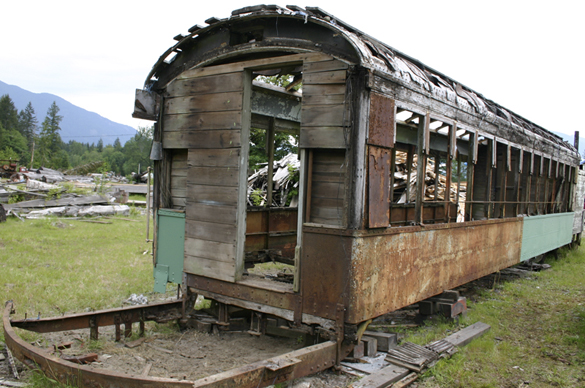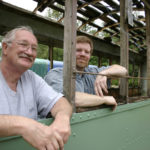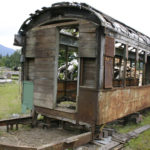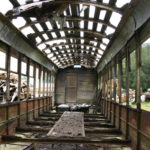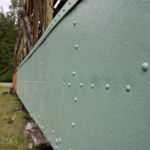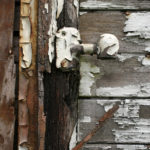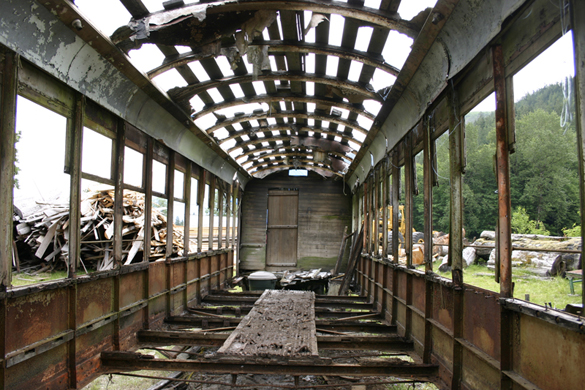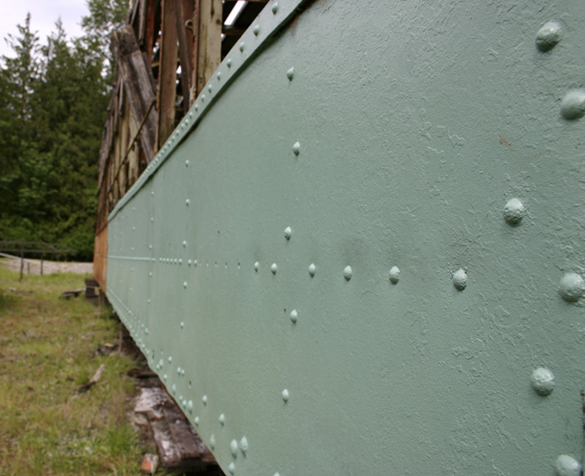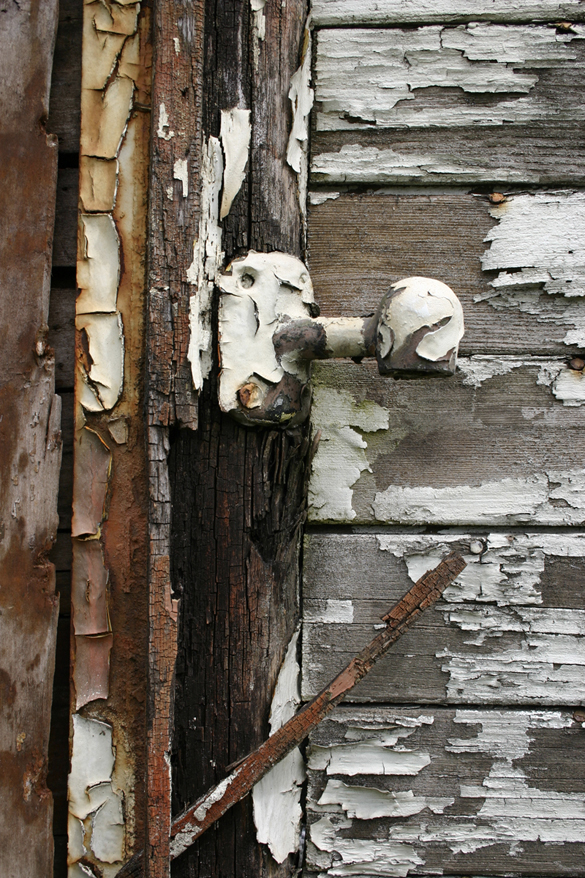IN THE NORTH Cascade foothills, just outside the town of Darrington — where tourists stop to fuel SUV’s, and grizzled men with long beards steer Harley Davidson motorcycles northeast toward Winthrop — a stretch of Washington State Route 530 exists where something almost unnoticeable happens: the speed limit loosens and roadside Douglas Firs reach toward a sooty glaze of clouds to form a column that seems to pull drivers east toward the small town of Rockport.
On this stretch of highway, ghosts of timbermen live. Wearing sore backs like belts, clutching lunch pails and hard hats, and fixed with stoic gazes appropriate for the work ahead, loggers once traveled along a “speeder route” — a railway line that existed for the sole purpose of chartering workers back and forth between Darrington and logging camps buried deep in hillside forest folds.
Today, speeder tracks have been replaced by two lanes of asphalt — namely, State Route 530. And though the logging industry is mostly gone, its connection to the railroad continues. On a 40-acre spread of land just off the highway lies a strange collection of, well, stuff. Drive onto the property, and the first thing you will likely notice is the massive shell of a former carnival rocket, tipped like a tornado-struck grain silo. Scattered throughout the property are shells of old Ford pickup trucks, each in some late stage of decay, each suffering some fatal flaw: a gutted engine, one or more missing tires, overgrown grass that has crawled into their undersides. Further, a portable saw mill sits between massive log piles. Keeping sentry over this strange rural setting is a double-wide trailer that serves as the property owner’s home.
The reason someone from Tacoma might want to travel 130 miles to this open field is simple. Two vintage streetcars rest on a bluff overlooking a small pond: a 1919, 27-foot Birney model, and a 1908, 49-foot Turtleback model.
The latter operated on Tacoma’s streets nearly a century ago.
The streetcars belong to Tom and Vince Mendenhall, a father-and-son team of history buffs and entrepreneurs who own Historic Railway Restoration — the Arlington-based company that has restored heritage locomotives, streetcars, and speeder trains for U.S. and Canadian cities since the late-1980s.
“There they are,” says Vince Mendenhall. He shifts his maroon GMC Jimmy into park, turns off the engine, and climbs out. Vince, 37, is a big man with a thick bush of red hair, and a goatee flecked gray. Earlier, as he was leaving Arlington, he warned that the streetcars were in bad shape.
“Are you ready to look at two pieces of junk?” he asked.
Vince’s father, Tom, quickly followed up with a clarification: “Two pieces of junk with a lot of history and potential.”
An hour later, Vince’s critique was realized.
Natural elements have gnawed the two streetcars: steady rains; sharp winds; seasonal freezing and thawing that has occurred like a slow pulse since the cars were hauled here nearly two years ago. Both cars lack wheels and windows. The Birney car is buried beneath layers of tarps, an effort to protect it from more damage. The Turtleback, however, sits exposed. It’s holey and shelled. Your first thought: it’s either been car-bombed or is in the process of trying to disappear itself.
Still, it holds eerie beauty. Climb inside, and a late-morning gray light creeps through an arched roof pockmarked by holes and gashes. And a coral green steel siding runs both lengths of the car: though missing in some patches, it’s the old car’s only color.
“Structurally, it’s a very sound car,” says Tom, 66, who sports blue jeans, faded T-shirt, and large glasses that front a friendly, wrinkled face with a silver moustache and thinning hair. He circles the Turtleback while navigating land mines of patties left by cows known to roam the area. The cars are here thanks to a friendly, loose agreement between the property owner and the Mendenhalls (the property owner also happens to store a rail car in Concrete, which Tom and Vince are restoring). “It’s not bending or bowing. Rebuilding them is not a problem. You’re probably looking at about $650,000 on the Turtleback, and $400,000 on the Birney. And that would include brand-new trucks, propulsion, air system, glass windows, and electrical wiring.”
He estimates it would take 16 months to restore the Turtleback, and nine months to a year for the Birney.
A visit to these streetcars is timely. Last week, the City of Tacoma’s environment and public works committee approved the findings of a six-month study, directed by Tacoma City Council, which examined whether it’s viable to restore Tacoma’s heritage streetcar system. A team of City staff, representatives from Pierce Transit and Sound Transit, and a grassroots group of residents and historians looked at other cities that restored heritage streetcars and determined these systems spur economic development, bolster transit use, and contribute to a city’s character.
Will Tacoma build a streetcar system?
That remains to be seen, as City staff will continue to study the idea.
But if it does, the City could look to the Mendenhalls and their Tacoma car as part of a solution.
HOW DID THESE streetcars wind up in Rockport, 130 miles north of Tacoma?
The answer traces back to the late Walter Mendenhall Toms father, Vinces grandfather. A train enthusiast his entire life, Walter collected books for decades, and donated most of them to museums around the country. “He was really a train nut,” recalls Vince, whose grandfather passed away in 1965.
In 1978, the Mendenhalls were on a road trip to the Oregon Coast when they stopped in at the Oregon Electric Railway Historical Society’s trolley museum in Brooks, Ore. Tom introduced himself, and staff were very familiar with the Mendenhall name: ‘We knew your father. We still have his books.’
Over the next five years, the family kept contact with museum staff. In 1983, the museum was organizing a trolley festival and wanted to lease some cars from San Francisco. Tom had a Class A tractor-trailer license, and offered to transport the cars. That led to an opportunity to rebuild some of the streetcars. Tom had experience restoring hot rods and tackling carpentry tasks. He was also an amateur historian. “I love reading books, and I’m mechanically inclined,” he explains. “The only difference between a streetcar and a hot rod is one has 600 volts DC, and one has a gas engine.”
When the project was finished, Tom and Vince were hooked on streetcar restoration.
In 1989, Tom retired from the City of Seattle, where he worked for 30 years as a meter reader, and Vince graduated high school. “My dad decided to go and do streetcar restoration as a sole proprietor, and I just took off after high school,” Vince explains.
It was a short hiatus.
South Carolina Electric & Gas called offering a job restoring an old Birney safety car. Tom and Vince moved to South Carolina to work on the project full-time. “They were just really happy with the work,” says Vince. “We started doing little jobs here and there.”
Between 1989 and 1995, the pair roamed the U.S. and Canada working on a variety of streetcar restoration projects. They stayed at more motels and ate at more fast-food restaurants than they can (or care to) recall.
There was a 345-ton steam locomotive in Ottumwa, Iowa; three streetcars for the City of Detroit; a streetcar in Minnesota for a private collector; a streetcar in Whitehorse, in the Yukon Territory of Canada; and a handful of local projects cabooses in Kingston, Lynnwood, and Kent, and work on the Monorail at Seattle Center.
DURING THAT PERIOD, the Mendenhalls started to notice something unusual. Streetcars were consistently popping up in the same locations: residential backyards.
How does someone wind up with a backyard streetcar?
In the 1930s, according to Tom, cities moved away from streetcars and toward automobiles. Many municipalities were saddled with unwanted inventories of streetcars.
“To the transit agencies, [streetcars] were at the end of their lives,” says Vince. “They were scrapping them. If you go to some of the museums, they will have pictures of car bodies stacked and on fire. They would take all the metal, scoop it up, and make money off that.”
“And even then, it was costing them money to scrap them,” adds Tom. “They had all the glass and wood you had to clean up and get rid of. Selling the metal did not make the amount you needed to cover the costs of labor and everything. That’s why they sold a lot of them. For a dollar, you could buy a streetcar body. For 50 dollars, you could ship it on the railroad wherever you wanted.”
The result was a score of streetcars used for a variety of purposes: storage space in backyards; diner cars at kitschy restaurants; and even some built onto existing homes to create additional space.
“When you hear the term ‘chicken coop,’ streetcars were literally turned into just that,” says Vince. “And storage shelters. Anything like that.”
That’s how the Mendenhalls found the old Tacoma Turtleback.
The eight-wheel, double-truck streetcar was sitting in a backyard in Auburn. In 2003, Tom and Vince had heard about it through their network of streetcar enthusiasts and museum operators. “We went down there one day and said, ‘We can’t do it right now, but sometime in the next six months, we’d like to stop in and see about buying the body.’ He said, ‘OK.’ The neighbors heard about it, and they came running and screaming, and said, ‘Take it away now!’ It was in that bad of a shape.”
It was a similar story for the smaller, four-wheel, single-truck Birney streetcar. In the mid-1990s, Tom and Vince learned it was sitting in someone’s backyard in Black Diamond. They negotiated a purchase.
Today, the Mendenhalls own seven streetcars, locomotives, and speeders scattered throughout Washington, Oregon, and California.
“It’s actually a network,” says Tom, explaining how they find streetcars and parts. “Everybody in this business either works in museums or knows each other. You can call anybody and say, ‘I’m looking for this. Who should I talk to?'”
EARLIER THIS YEAR, the last of two back-to-back jobs left the Mendenhalls’ rented shop in Arlington: one streetcar bound for San Francisco, another headed to Kansas City. This week, Tom is headed to Yreka, Calif., to load a 25-ton locomotive. Then he will head to Colorado to inspect a steam locomotive that needs restoration. Other than work on a caboose in Kent, and a goal this year to sandblast and repair the roofs on streetcars they own, the pair is in a quiet spell. It would seem like a nice break from back-to-back projects, but a follow-up phone call this week to Vince, who builds airplanes full-time at a Boeing plant in Everett, reveals some frustration: he can’t wait to get started on the next streetcar project.
He’s not alone.
When Historic Railway Restoration is awarded a contract, it contacts a local union to hire two or three carpenters to help complete the project. Carpenters often call asking if there’s any streetcar work.
“Union carpenters will leave jobs they’re at to come work for us, even if it’s for six months,” says Vince. “They work on square boxes all day long. They get around these [streetcars] and put one back together, and they love it.”
The Mendenhalls started their company in Ballard, but moved to Arlington in search of cheaper rent. They also learned that most of their vendors are based in Snohomish and Skagit Counties.
They want to purchase land — ideally near railroad tracks — that will serve as a permanent home. The company operates out of a rented trailer in a lumber company’s gravel parking lot. A massive shop across the way is where they work on streetcars.
Though grateful for the space, they want a permanent location for all their scattered streetcars.
“We don’t like the idea of trying to bring a car body in and restoring it in a rented building,” explains Vince. “We don’t want someone to come in and say, ‘Well, we’re developing the property and you have to leave,’ and we’re halfway through a car body.
“We’re still a little company just plugging along,” he adds. “But we met a lot of people have been to a lot of places, and that has a lot of value in itself. Hopefully, in the next few years, there will be a big explosion of cities wanting streetcars, and we can supply them.”
To read a Q & A Interview with the Mendenhalls, click here.
Todd Matthews is editor of the Tacoma Daily Index and recipient of an award for Outstanding Achievement in Media from the Washington State Department of Archaeology and Historic Preservation for his work covering historic preservation in Tacoma. His work has also appeared in All About Jazz, City Arts Tacoma, Earshot Jazz, Homeland Security Today, Jazz Steps, Journal of the San Juans, LynnwoodMountlake Terrace Enterprise, Prison Legal News, Rain Taxi, Real Change, Seattle Business Monthly, Seattle magazine, Tablet, Washington CEO, Washington Law & Politics, and Washington Free Press. He is a graduate of the University of Washington and holds a bachelor’s degree in communications. His journalism is collected online at wahmee.com.
